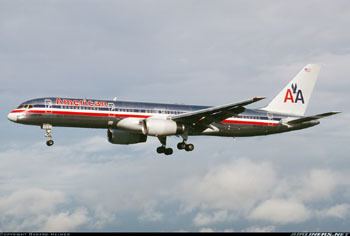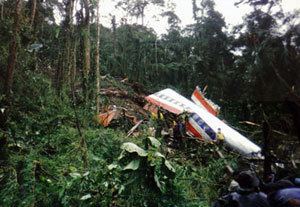Passengers 163 Survivors 4 (initially 5) Date 20 December 1995 Survivor 4 (initially 5) | Crew 8 Injuries (nonfatal) 4 Total fatalities 159 (1 at hospital) Passenger count 163 | |
 | ||
Similar Atlantic Southeast Airlines Fl, American Airlines Flight 1420, Aeroperú Flight 603, British Airways Flight 5390, Ethiopian Airlines Flight 961 | ||
American Airlines Flight 965 was a regularly scheduled flight from Miami International Airport in Miami, Florida, to Alfonso Bonilla Aragón International Airport in Cali, Colombia. On December 20, 1995, the Boeing 757-200 flying this route (registration N651AA) crashed into a mountain in Buga, Colombia, killing 151 passengers and eight crew members. The crash was the first U.S.-owned 757 accident and the highest death toll of any accident in Colombia. It is also the highest death toll of any accident involving a Boeing 757 at that time. It was surpassed by Birgenair Flight 301 which crashed in 1996 with 189 fatalities. Flight 965 was the deadliest air disaster involving a U.S. carrier since the bombing of Pan Am Flight 103 in 1988. Five passengers, all seated within two rows of each other, survived the initial impact, but one died two days later of his injuries.
Contents
- Aircraft
- Departure
- Going off course
- Crash
- Aftermath
- Crash investigation and final report
- Dramatization
- Notable passengers
- References

The Colombian Special Administrative Unit of Civil Aeronautics investigated the accident and determined it was caused by navigational errors by the flight crew.

Aircraft

The aircraft was a Boeing 757-223 registered N651AA. Its first flight was on August 12, 1991, and was the 390th Boeing 757 built. The aircraft was powered by two Rolls-Royce RB211 engines.
Departure

At that time, Flight 965 mainly carried people returning to Colombia for the Christmas holiday, vacationers and businesspeople. A winter storm in the northeast United States caused the airline to delay the departure of the airliner for thirty minutes to allow for connecting passengers to board the flight, so Flight 965 pushed back from the gate in Miami at 5:14 pm, and then taxied to runway 27R, but seasonal congestion caused the Boeing 757 to take off two hours late. Some other passengers booked on Flight 965 missed the flight due to missed connections.

The cockpit crew consisted of Captain Nicholas Tafuri, 57, and First Officer Donald Williams, 39. Both pilots were considered to be highly skilled airmen. Tafuri had more than 13,000 hours of flying experience and Williams had almost 6,000 hours. The cabin crew consisted of Purser Pedro Pablo Calle and Flight Attendants Magdalena Borrero, Rosa Cabrejo, Teresa Delgado, Gilberto Restrepo, and Margaret "Maggie" Villalobos. All cabin crew personnel were born in Colombia and were veterans from Braniff International Airways who had moved to Eastern Air Lines and then to American Airlines, when the routes were transferred from one airline to the other. They had voluntarily chosen the flight, as a prerogative awarded by seniority, to spend Christmas time with their families in Bogotá.
Going off-course
Cali's air traffic controllers had no functional radar to monitor the 757, as it had been blown up in 1992 by the terror group FARC. Cali's approach uses several radio beacons to guide pilots around the mountains and canyons that surround the city. The airplane's flight management system already had these beacons programmed in, and should have, in theory, told the pilots exactly where to turn, climb, and descend, all the way from Miami to the terminal in Cali.
Since the wind was calm, Cali's controllers asked the pilots whether they wanted to fly a straight-in approach to runway 19 rather than coming around to runway 01. The pilots agreed, hoping to make up some time. The pilots then erroneously cleared the approach waypoints from their navigation computer. When the controller asked the pilots to check back in over Tuluá, north of Cali, it was no longer programmed into the computer, and so they had to pull out their maps to find it. In the meantime, they extended the aircraft's speed brakes to slow it down and expedite its descent.
By the time the pilots found Tuluá's coordinates, they had already passed over it. In response to this, they attempted to program the navigation computer for the next approach waypoint, Rozo. However, the Rozo NDB was identified as R on their charts. Colombia had duplicated the identifier for the Romeo NDB near Bogotá, and the computer's list of stored waypoints did not include the Rozo NDB as "R", but only under its full name "ROZO". In cases where a country allowed duplicate identifiers, it often listed them with the largest city first. By picking the first "R" from the list, the captain caused the autopilot to start flying a course to Bogotá, resulting in the airplane turning east in a wide semicircle. By the time the error was detected, the aircraft was in a valley running roughly north-south parallel to the one they should have been in. The pilots had put the aircraft on a collision course with a 3,000-meter (9,800 feet) mountain. The air traffic controller, Nelson Rivera Ramírez, believed that some of the requests of the pilots did not make sense, but did not know enough non-aviation English to convey this.
Crash
Twelve seconds before the plane hit the mountain, named El Diluvio (The Deluge), the Ground Proximity Warning System activated, announcing an imminent terrain collision and sounding an alarm. Within a second of this warning the first officer disengaged the autopilot, and the captain attempted to climb clear of the mountain; however, neither pilot had remembered to disengage the previously deployed speed brakes, which reduced the rate of climb. At 9:41:28 pm Eastern Standard Time it struck trees at about 8,900 feet MSL on the east side of the mountain. The crash was six miles south of Tuluá VOR and 28 miles north of the approach end of runway 19 at Alfonso Bonilla Aragon International Airport. During the investigations, it was found that neither the Boeing fixed-base simulator nor the CDU/FMS simulator could be backdriven with the data obtained directly from the accident airplane's flight data recorder. Because the B-757 flight simulators could not be backdriven during the tests, it could not be determined with precision whether the airplane would have missed the mountain/tree tops if the speedbrakes had been retracted during the escape attempt. However, the final report stated that if the flightcrew had retracted the speedbrakes one second after initiating the escape maneuver, the airplane could have been climbing through a position that was 150 feet above the initial impact point. Because the airplane would have continued to climb and had the potential to increase its rate of climb, it may well have cleared the trees at the top of the mountain.
Aftermath
Scavengers took engine thrust reversers, cockpit avionics, and other components from the crashed 757, using Colombian military and private helicopters to go to and from the crash site. Many of the stolen unapproved aircraft parts re-appeared on the black market in Greater Miami parts brokers. In a response, the airline published a 14-page list stating all of the parts missing from the crashed aircraft. The list included the serial numbers of all of the parts.
In 1997 U.S. District Judge Stanley Marcus ruled that the pilots had committed "willful misconduct"; the ruling applied to American Airlines, which represented the deceased pilots. The judge's ruling was subsequently reversed in June 1999 by the U.S. 11th Circuit Court of Appeals in Atlanta, which also overturned the jury verdict and declared that the judge in the case was wrong in issuing a finding of fault with the pilots, a role which should have been reserved for the jury only.
American Airlines settled numerous lawsuits brought against it by the families of the victims of the accident. American Airlines filed a "third-party complaint" lawsuit for contribution against Jeppesen and Honeywell, which made the navigation computer database and failed to include the coordinates of Rozo under the identifier "R"; the case went to trial in United States District Court for the Southern District of Florida in Miami. At the trial, American Airlines admitted that it bore some legal responsibility for the accident. Honeywell and Jeppesen each contended that they had no legal responsibility for the accident. In June 2000, the jury found that Jeppesen was 30 percent at fault for the crash, Honeywell was 10 percent at fault, and American Airlines was 60 percent at fault.
An enhanced ground proximity warning system was introduced in 1996, which could have prevented the accident.
Since 2002, all planes with more than six passengers are required to have an advanced terrain awareness warning system. No aircraft fitted with a TAWS/EGPWS suffered a controlled flight into terrain accident until July 28, 2010, when Airblue Flight 202 crashed into the Margalla Hills, Pakistan.
As of September 2016, American Airlines still operates the Miami-Cali route, but as American Airlines Flight 921 and using an Airbus A319.
Crash investigation and final report
The crash was investigated by the Special Administrative Unit of Civil Aeronautics (Aeronáutica Civil) of the Republic of Colombia, with assistance from the U.S. National Transportation Safety Board (U.S. NTSB) as well as other parties, including the U.S. Federal Aviation Administration, Allied Pilots Association, American Airlines, Boeing Commercial Airplane Group and Rolls Royce Engines.
The Aeronáutica Civil prepared a final report of its investigation in September 1996, which was released through the U.S. NTSB.
In its report, the Aeronáutica Civil determined the following probable causes of the accident:
- The flight crew's failure to adequately plan and execute the approach to runway 19 at SKCL and their inadequate use of automation.
- Failure of the flightcrew to discontinue the approach into Cali, despite numerous cues alerting them of the inadvisability of continuing the approach.
- The lack of situational awareness of the flightcrew regarding vertical navigation, proximity to terrain, and the relative location of critical radio aids.
- Failure of the flightcrew to revert to basic radio navigation at the time when the FMS-assisted navigation became confusing and demanded an excessive workload in a critical phase of the flight.
In addition, the Aeronáutica Civil determined that there were the following contributing factors to the accident:
- The flight crew's ongoing efforts to expedite their approach and landing in order to avoid potential delays.
- The flight crew's execution of the GPWS escape maneuver while the speedbrakes remained deployed.
- FMS logic that dropped all intermediate fixes from the display(s) in the event of execution of a direct routing.
- FMS-generated navigational information that used a different naming convention from that published in navigational charts.
The Aeronáutica Civil's report also included a variety of safety-related recommendations to the following parties (number of individual recommendations in parentheses):
Investigators later labeled the accident a non-survivable event.
Dramatization
Notable passengers
The U.S. encountered difficulty while trying to distinguish Americans from non-Americans, as many passengers held dual citizenships.
